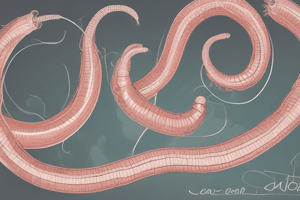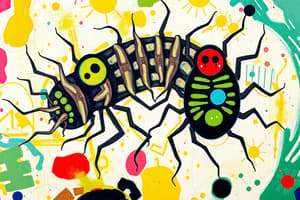Podcast
Questions and Answers
What is the length that adult Dypilidium caninum can grow up to?
What is the length that adult Dypilidium caninum can grow up to?
- 70 cm
- 50 cm (correct)
- 20 cm
- 100 cm
Which stage of Dypilidium caninum is responsible for egg release?
Which stage of Dypilidium caninum is responsible for egg release?
- Larval stage
- Cysticercoid
- Adult stage
- Gravid proglottids (correct)
What is the primary intermediate host for Dypilidium caninum?
What is the primary intermediate host for Dypilidium caninum?
- Cats
- Rats
- Fleas (correct)
- Dogs
How do definitive hosts typically become infected with Dypilidium caninum?
How do definitive hosts typically become infected with Dypilidium caninum?
What occurs after the eggs of Dypilidium caninum are ingested by fleas?
What occurs after the eggs of Dypilidium caninum are ingested by fleas?
Which of the following describes the mode of transmission of Dypilidium caninum?
Which of the following describes the mode of transmission of Dypilidium caninum?
Which life stage of fleas does the cysticercoid of the tapeworm develop in?
Which life stage of fleas does the cysticercoid of the tapeworm develop in?
What is a highly effective method to prevent Dypilidium caninum infection?
What is a highly effective method to prevent Dypilidium caninum infection?
Flashcards are hidden until you start studying
Study Notes
Dypilidium caninum - Life Cycle
-
General Overview:
- Dypilidium caninum, commonly known as the dog tapeworm, is a parasitic flatworm that primarily infects dogs and cats but can also infect humans.
-
1. Adult Stage:
- Adult tapeworms reside in the intestines of definitive hosts (dogs and cats).
- They attach to the intestinal wall using hooks and suckers.
- Adult worms can grow up to 50 cm in length.
-
2. Gravid Proglottids:
- The tapeworm consists of segments called proglottids.
- Gravid proglottids (containing eggs) are released in the host's feces.
- These segments are motile and can crawl away from the feces.
-
3. Intermediate Host:
- Eggs are ingested by intermediate hosts, usually fleas (Ctenocephalides spp.).
- Inside the flea, eggs develop into larval forms containing the infective stage of the tapeworm (cysticercoid).
-
4. Flea Lifecycle:
- Fleas undergo several life stages: egg, larva, pupa, and adult.
- Cysticercoid develops in the flea's larval stage.
-
5. Infection of Definitive Host:
- Definitive hosts become infected by ingesting infected fleas (often during grooming).
- The cysticercoid develops into an adult tapeworm in the intestines of the host.
-
6. Transmission:
- The life cycle continues when the host defecates, releasing proglottids and eggs into the environment.
- Ingestion of fleas by pets is the primary transmission route.
-
7. Human Infection:
- Humans can become infected, particularly children who may accidentally ingest fleas.
- Infection in humans is typically asymptomatic but can lead to mild gastrointestinal symptoms.
-
8. Prevention:
- Regular flea control in pets is crucial to prevent infection.
- Maintaining hygiene and reducing flea exposure can help break the life cycle.
Summary
Dypilidium caninum has a complex life cycle involving adult tapeworms in definitive hosts, development within flea intermediate hosts, and transmission through flea ingestion. Effective prevention focuses on controlling flea populations in pets.
Genel Görünüm
- Dypilidium caninum, evcil hayvanlarda yaygın olarak görülen bir parazitik düz solucandır.
- Enfeksiyon genellikle köpekler ve kedilerde görülse de, insanlar da etkilenebilir.
Yetişkin Aşama
- Yetişkin solucanlar, belirleyici konakların (köpekler ve kediler) bağırsaklarında yaşar.
- Bağırsak duvarına tırnaklar ve emici organlar kullanarak yapışırlar.
- Yetişkin tapewormlar, 50 cm uzunluğa kadar büyüyebilir.
Gravid Proglottidler
- Tapeworm, proglottid adı verilen segmentlerden oluşur.
- Gravid proglottidler, ev sahibi dışkısında bulunan yumurtaları içerir ve dışarı atılır.
- Bu segmentler, dışkıdan uzaklaşabiliyor.
Ara Konak
- Yumurtalar genellikle pireler (Ctenocephalides spp.) tarafından tüketilir.
- Pire içinde, yumurtalar enfekteli evrede (kistiserkoid) gelişen larva formlarına dönüşür.
Pire Yaşam Döngüsü
- Pireler, yumurta, larva, pupa ve yetişkin aşamalardan geçer.
- Kistiserkoid, pirelerin larval aşamasında gelişir.
Kesin Konak Enfeksiyonu
- Kesin konaklar, enfekte pireleri yediklerinde enfekte olurlar (genellikle tüylerini temizlerken).
- Kistiserkoid, konak bağırsaklarında yetişkin tapeworm haline gelir.
Bulaşma
- Yaşam döngüsü, konak dışkılayınca proglottidleri ve yumurtaları çevreye bıraktığında devam eder.
- Evcil hayvanların pireleri yutması, ana bulaşma yoludur.
İnsan Enfeksiyonu
- İnsanlar, özellikle çocuklar, yanlışlıkla pireleri yuttuklarında enfekte olabilirler.
- İnsanlarda enfeksiyon genellikle asemptomatik olsa da, hafif gastrointestinal belirtilere yol açabilir.
Önleme
- Evcil hayvanlarda düzenli pire kontrolu, enfeksiyonu önlemek için kritik öneme sahiptir.
- Hijyenin korunması ve pire maruziyetinin azaltılması, yaşam döngüsünü kırmaya yardımcı olabilir.
Studying That Suits You
Use AI to generate personalized quizzes and flashcards to suit your learning preferences.



